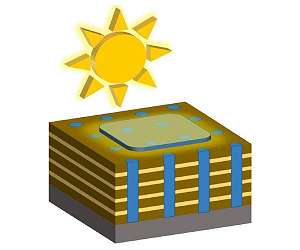Lead halide perovskites, with high refractive index and excellent optoelectronic property, have been used in both constructing high-quality optical resonators/lasers and fabricating high-efficiency light-emitting devices for advanced displays. Lenticular printing provides an illusion of depth and shows varying images upon view angles, which is considered as a promising approach towards future stereoscopic displays.
To realize lenticular-printing-based display, it is required to modulate the outcoupling direction of emission light rather than that of incident light. Ideally, the lenticular-lens-like structures would be integrated into the active layer of light-emitting devices.
Therefore, the hybrid perovskite becomes a promising candidate for the investigation of lenticular printing display; however, it remains a challenge to realize large-area periodic structures of perovskite materials especially with a feature size of wavelength scale.
Very recently, Dr. Chuang Zhang, Dr. Yong Sheng Zhao from Institute of Chemistry, Chinese Academy of Sciences, Dr. Yuchen Wu from Technical Institute of Physics and Chemistry, Chinese Academy of Sciences, and their colleagues fabricated lead halide perovskite periodic structures via a space-confined solution growth method.
The spatial resolution could be down to hundreds of nanometers while the substrate size up to several centimeters. These structures were able to not only modulate the reflection of visible light, but also control the angle of light emission from hybrid perovskites.
More importantly, the low-threshold lasing based on distributed feedback was observed from the periodic structures, and its narrow line-width offered possibility to realize the lenticular printing laser display, according to the wavelength-dependent outcoupling of emission colors.
A prototype of laser display panels was then realized based on the mixed halide perovskites, in which the green and red colored images were obtained at high and low angles respectively. This work would shed light on the design and fabrication of perovskites materials for new types of display techniques.
Research Report: “Large-area periodic lead halide perovskite nanostructures for lenticular printing laser displays”
Related Links
Science China Press
All About Solar Energy at SolarDaily.com
|
We need your help. The SpaceDaily news network continues to grow but revenues have never been harder to maintain. With the rise of Ad Blockers, and Facebook – our traditional revenue sources via quality network advertising continues to decline. And unlike so many other news sites, we don’t have a paywall – with those annoying usernames and passwords. Our news coverage takes time and effort to publish 365 days a year. If you find our news sites informative and useful then please consider becoming a regular supporter or for now make a one off contribution. |
||
|
SpaceDaily Contributor $5 Billed Once credit card or paypal |
SpaceDaily Monthly Supporter $5 Billed Monthly paypal only |
|

![]()
Tiny 3D structures enhance solar cell efficiency
Halle, Germany (SPX) Feb 04, 2021
A new method for constructing special solar cells could significantly increase their efficiency. Not only are the cells made up of thin layers, they also consist of specifically arranged nanoblocks. This has been shown in a new study by an international research team led by the Martin Luther University Halle-Wittenberg (MLU), which was published in the scientific journal Nano Letters.
Commercially available solar cells are mostly made of silicon. “Based on the properties of silicon it’s not feasib … read more
